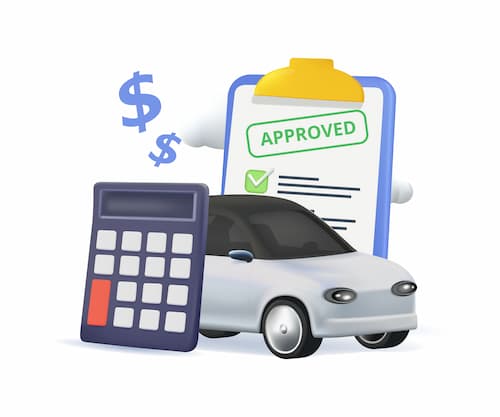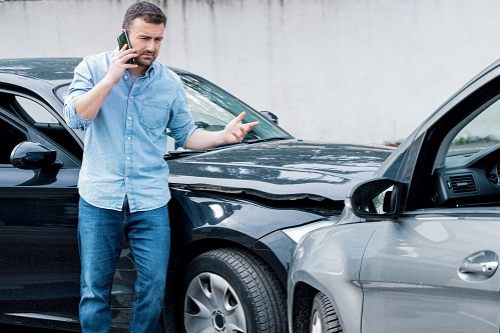- The five main types of car insurance
- Liability insurance
- Comprehensive and collision insurance
- Uninsured/underinsured motorist insurance
- Personal injury protection and medical payments insurance
- Other types of car insurance coverage
- Other types of car insurance policies
- What type of car insurance do you need?
- Choosing car insurance coverage: Our expert tips
- Methodology
- FAQ: Types of car insurance
The five main types of car insurance
There are five main types of auto insurance coverage. Depending on where you live, several of these may be legal requirements. Knowing your state’s laws before shopping is important, as some require coverage beyond basic liability. If you have a loan or lease, the three types of car insurance at the top of the list below will be required for a full coverage policy.
- Liability insurance is required by law in almost every state and pays for injuries and damages for others when you are at fault. It is broken up into bodily injury and property damage coverages.
- Comprehensive insurance is required if you have a loan or a lease and pays for damages to your vehicle that are unrelated to an accident, such as vandalism, theft, fire or animal strikes.
- Collision insurance is required if you have a loan or a lease and covers damages to your car in an accident, regardless of fault.
- Uninsured/underinsured motorist insurance covers personal injury and property damage if you’re involved in an accident with an uninsured or underinsured motorist, and is required by law in some states.
- Personal injury protection and medical payments insurance are required by law in some states and cover medical bills for you and your passengers regardless of fault.
Liability insurance
Protects your finances: Liability insurance is required by law in most states
What does it cover?
If you cause an accident, liability insurance covers the other driver’s vehicle repairs and medical expenses. It also protects you in a lawsuit if the other driver sues you for their losses.
Who should buy it?
Every driver should have personal liability insurance. Plus, it’s a legal requirement in every state except New Hampshire.
Other factors to consider
If your state requires car insurance, you must purchase a minimum amount of liability coverage to register your vehicle and legally drive. However, the minimum amount of coverage may not be adequate.
It’s a good idea to raise your liability coverage limits for more protection. Otherwise, you risk paying out-of-pocket in a lawsuit.
How much does liability insurance cost?
The nationwide average cost for state minimum liability coverage is $618, but your rate will be higher if you purchase more coverage and will differ by state.
Comprehensive and collision insurance
Protects your car: Comprehensive and collision insurance are required by most auto lenders
What do they cover?
Collision and comprehensive insurance cover vehicle repairs and comprise full coverage insurance.
Collision pays for your car’s repairs after an accident, and comprehensive pays for the damage to your car from a non-collision incident, like fire, theft, vandalism or hail. Both policies have a deductible that comes out of your insurance payout.
Who should buy them?
You should purchase collision and comprehensive insurance if you have a loan or lease your vehicle. Most lenders will require you to have it. It’s also highly recommended for anyone who couldn’t afford to pay for vehicle repairs or replacement out-of-pocket.
Other factors to consider
These coverages are generally sold together, but you can buy them individually in some cases. You can also have different deductibles for each of them.
How much do comprehensive and collision insurance cost?
The average annual cost for collision insurance is $995, and $588 for comprehensive insurance, according to our most recent rates. Choosing a higher deductible may save you money, but it should never exceed an amount you can afford.
Uninsured/underinsured motorist insurance
Protects you from uninsured drivers: Some form of UM/UIM may be required in your state
What does it cover?
Uninsured/underinsured motorist coverage (UM/UIM) pays for your vehicle repairs and your medical expenses if you get into an accident with a driver who doesn’t have car insurance or doesn’t have enough car insurance to cover your losses in full.
Who should buy it?
Some states require one or both coverages, so it’s not always optional. States that require some form of UM/UIM are CT, IL, KS, MA, MD, ME, MN, MO, NC, ND, NE, NH, NY, OR, SC, SD, VA, VT, WI, WV, and D.C. If your state doesn’t require uninsured or underinsured motorist coverage, it can provide additional peace of mind, especially if you don’t have a full coverage policy.
Other factors to consider
Typically, your uninsured motorist bodily injury coverage limits cannot be greater than the amount of liability insurance you have. We recommend buying uninsured and underinsured motorist bodily injury limits that match your liability coverage if you don’t have health insurance. We also recommend buying property damage if you do not carry collision coverage.
How much does uninsured/underinsured motorist insurance cost?
On average, uninsured/underinsured motorist coverage costs $199 a year.
Personal injury protection and medical payments insurance
Protects you with no-fault medical coverage: PIP is required by law in no-fault states and a few other states as well
What does it cover?
Personal injury protection (PIP) and medical payments insurance (MedPay) pay for the cost of treating injuries that you, authorized drivers or your passengers suffer in a car accident regardless of fault.
Who should buy it?
Personal injury protection is required in these states: DE, FL, HI, MI, MA, KS, MN, NY, UT, OR, ND, and NJ. Most are no-fault states, which means each driver’s insurance company pays for their injuries, no matter who causes the accident.
Medical payments coverage is usually optional and comes with a full coverage policy. It’s only mandatory in Maine and for insured drivers in New Hampshire, where insurance coverage is not required.
Other factors to consider
If personal injury protection or medical payments coverage is optional in your state and you already have health insurance, we recommend buying enough to cover your deductible. If you do not have health insurance, we strongly recommend you buy at least $10,000 in personal injury protection or $5,000 in medical payments coverage.
How much do personal injury protection and medical payments insurance cost?
The average cost of personal injury protection is $191 per year. For medical payments insurance, the average rate is $20 per year.
Other types of car insurance coverage
When you buy car insurance, you’ll have the option to add additional coverage. Here are several car insurance coverage types to consider for extra protection:
- Rental reimbursement. Rental reimbursement insurance will cover the cost of a rental car while your car is being repaired for a covered claim. Some insurance companies include this coverage as part of a standard policy. The cost of rental car reimbursement depends on your insurance company and the amount of coverage you choose.
- Emergency roadside assistance/towing and labor. Emergency roadside assistance, also called towing and labor coverage, will get your car back on the road if it breaks down. It typically covers fuel delivery, jumping a dead batter, flat tire changes, extrication and towing (up to a certain mileage). Roadside assistance can cost as little as $5 per month or as much as $100 per month. Pricier plans tend to offer more (and better) coverage.
- Mechanical breakdown insurance. Mechanical breakdown insurance will pay for certain vehicle repairs, even if it’s not part of a claim. It typically covers mechanical issues related to the transmission, engine, fuel system, brakes, air conditioning and power system. The cost of mechanical breakdown insurance varies based on the insurance company. Expect it to cost from $30 to $100 a year.
- Gap insurance. If you lease or finance your vehicle, gap insurance pays off your remaining loan balance if your car is totaled and you owe more than it is worth. You can buy gap insurance (or loan-lease payoff coverage) through your lender. It’s also available through standalone gap providers and many insurance companies. Gap insurance is about $41 per year. It's typically cheapest to buy through your current insurance company if it’s offered.
- New car replacement insurance. New car replacement insurance is an endorsement that will pay to replace your vehicle with a similar new one if your car gets totaled without regard for depreciation. The price of new car replacement insurance depends on your insurance company and your vehicle's make, model, and year.
Other types of car insurance policies
Depending on your needs, you might want to consider some other types of car insurance policies.
- Umbrella insurance. An umbrella insurance policy gives you extended personal liability coverage to help pay for legal expenses if you cause an accident and get sued by the other driver. The cost of umbrella insurance depends on your coverage limit. For example, if you have $1 million in coverage, the average premium is between $150-$300. On the other hand, a $5 million policy will run you between $375-$525.
- Pay-as-you-go/pay-per-mile insurance. Pay-as-you-go insurance or pay-per-mile insurance is a type of usage-based car insurance that you pay for based on miles traveled on top of a low flat rate. It is best suited for drivers who drive less than 10,000 miles per year.
- Non-owner insurance. Non-owner car insurance is a way to get car insurance if you don’t own a vehicle. It’s also required for drivers who don’t have a car but need to purchase liability insurance to keep their driver’s license. The average cost of a non-owner policy is $407 per year.
- Classic car insurance. Classic car insurance is designed to cover classic and collector cars. It covers the car’s agreed-upon value rather than the actual cash value, which includes depreciation. According to Hagerty, one of the leading classic car insurance providers, the average cost of classic car insurance is roughly 34% cheaper than regular insurance.
What type of car insurance do you need?
We recommend that drivers carry more than the state minimum for liability coverage because it's rarely enough, even with some states increasing the legal minimum requirements. Even a moderately serious accident will likely exceed state minimum limits, leaving you with mounting bills and possibly even a lawsuit.
It's best to carry as much car insurance coverage as you can afford. Reducing or dropping coverage you need to save money isn't a good idea; there are better ways to find a lower car insurance rate. However, you can drop car insurance you really don't need. If you have more than one vehicle or access to public transportation, you likely don't need rental car reimbursement. If your car is paid off and low-value, you can consider dropping comprehensive and collision coverage.
People ask
Is buying more than the minimum required coverage necessary?
By law, you only need to buy the minimum, and you only need to buy comprehensive and collision coverage if you have a loan. So, from the standpoint of legal requirements, additional coverage isn't necessary. However, minimum coverage may leave you with major financial exposure in an accident.
Choosing car insurance coverage: Our expert tips
- Carry all of the car insurance you're required to by law and by the terms of your loan or lease agreement.
- State minimum requirements do not provide enough liability coverage for even a moderately serious accident, and provide no coverage for your car.
- If your car insurance is too expensive, shop around to find an insurer that offers more affordable rates. Dropping or reducing your coverage can leave you with expensive bills if you're in an accident.
Methodology
National and state average rates are based on three coverage levels: state minimum, 50/100/50 liability-only, and full coverage with 100/300/100 liability and $500 deductibles.
Unless otherwise indicated, averages are based on our full coverage data set. This data set is based on:
- Bodily injury liability of $100,000 per person and $300,000 per incident
- Property damage liability of $100,000 per incident
- Comprehensive and collision deductibles of $500
- 40-year-old driver
- Honda Accord LX
- Good credit
- A clean driving record
- 12-mile commute, 10,000 annual mileage
Additional rate data is drawn based on:
- All available year, make and model data
- Ages ranging from 16 to 75
- Excellent, fair and poor credit
- All available traffic violations
- One or more at-fault accidents
Our rate data is fielded by Quadrant Information Services, encompassing data from 34,588 ZIP codes in all 50 states and Washington, D.C. and gathered from 220+ insurance companies.
FAQ: Types of car insurance
How do I know how much liability insurance coverage I need?
The amount of coverage you need is at least the minimum requirements in your state. Everyone has different car insurance needs, so choose coverage limits that you feel provide sufficient protection for your situation and fit within your budget.
For liability insurance, your coverage limit should be based on your personal assets. If you have investment accounts, savings, real estate or other assets that could be seized in the event of a lawsuit, it’s a good idea to increase your policy limits accordingly.
What is liability-only insurance?
Liability-only insurance is also called a minimum coverage policy. It means that your policy only includes bodily injury and property damage liability insurance, which apply if you hit another driver. Liability-only insurance doesn’t offer any coverage for your vehicle or your medical expenses after an accident.
Should I adjust my coverage when adding a teen driver?
If you’re adding a teen driver to your car insurance policy, it is a good idea to consider raising your coverage limits. Data show that drivers between the ages of 16-19 are more likely to get into an accident than any other age group.
However, keep in mind that adding a teen to your policy will cause your rate to increase. If you’re planning to add a teen driver to your policy and raise your coverage limits, make sure you’re taking advantage of all the discounts you qualify for.



